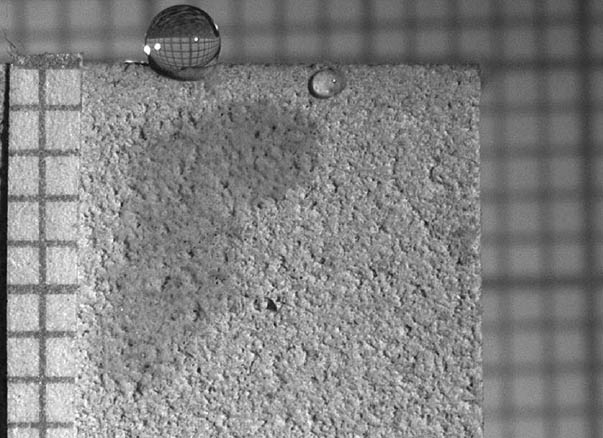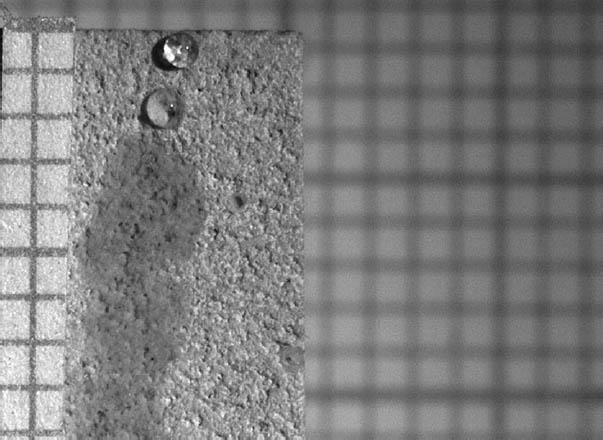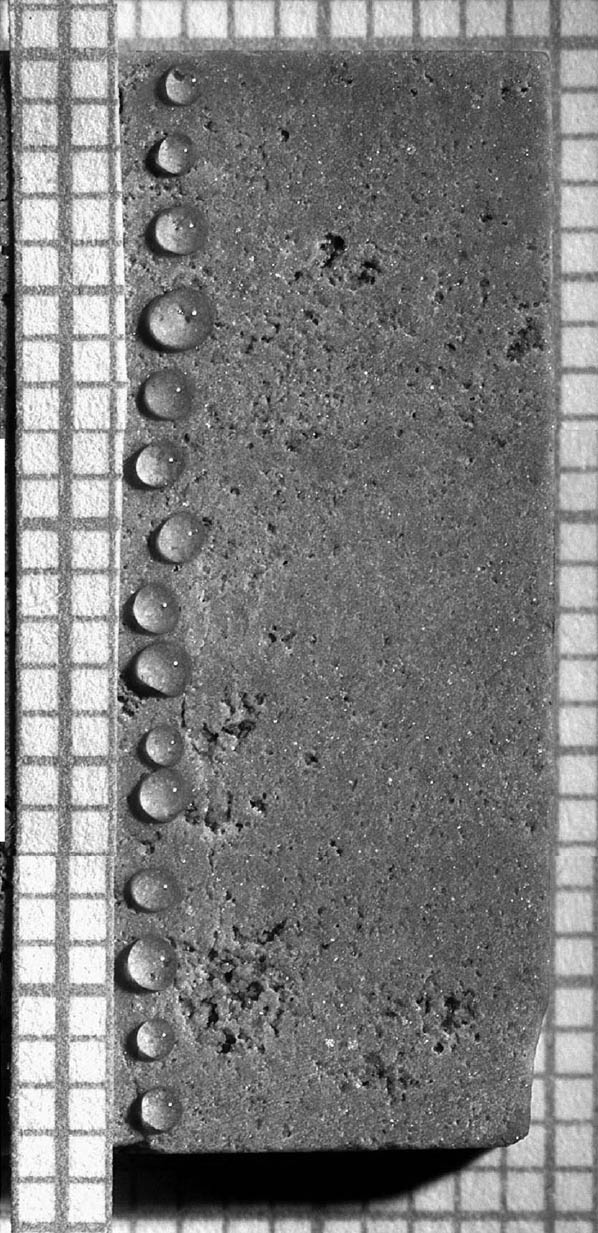POLYMER TREATMENTS FOR STONE CONSERVATION: METHODS FOR EVALUATING PENETRATION DEPTH
FRANCESCA CASADIO, & LUCIA TONIOLO
5 CONCLUSIONS
The results presented help to evaluate the potential of a wide range of infrared spectroscopic techniques, coupled to appropriate sampling methods, in identifying and characterizing, selectively and with good sensitivity, the depth of penetration of polymeric materials applied as protective treatments on stone substrates with different porosities. The experiments confirm that texture and porosity of the stone together with chemical nature and quantity of applied polymers can affect the pattern of resin distribution
Fig. 7.
Photomicrograph of the hydrophobization properties of the surface of a cross section of yellow Angera stone treated with Paraloid B-72 (photograph taken two minutes after deposition of microdrops; each bar indicates 1 mm)
 |
Fig. 8.
Photomicrograph of the hydrophobization properties of the surface of a cross section of Noto stone treated with Paraloid B-72 (photograph taken two minutes after deposition of microdrops; each bar indicates 1 mm)
 |
Fig. 9.
Photomicrograph of the hydrophobization properties of the surface of a cross section of Noto stone treated with TFEMA/MA (photograph taken two minutes after deposition of microdrops; each bar indicates 1 mm)
 |
and provide useful guidelines for selection of the most appropriate methodology to evaluate a treatment's penetration.
In general, micro-ATR is considered the most powerful and widely applicable technique for characterizing types of polymers and substrates. Micro-ATR has the highest spatial resolution and precision among the evaluated methods when good contact between the ATR crystal and the examined surface is obtained.
The other testing methods used in this study are also valuable, but they are affected by poor spatial resolution (due to the necessary sample preparation and cutting), and/or they are suitable for only a limited number of specific classes of polymers and stones. For example, TG-FTIR is effective for substrates treated with acrylics but not silicone resins, while diamond cell FTIR analysis of the residues of acid attack is useful only for calcareous stone, not for sandstones.
Application of these methods to the depth-profiling and mapping of polymer distribution within treated stones allows differentiation of various polymer behaviors. For medium-to-high porous stones (Angera limestone and Noto calcarenite), the following conclusions can be drawn:
- The partially fluorinated acrylic copolymer generally achieves greater penetration depths with respect to the nonfluorinated homologue, which, in turn, shows the greatest tendency to form a superficial coating on treated stones.
- The siloxane polymer has a great ability to impregnate the porous structure of treated stones.
With regard to stone substrates with very low porosity (such as marbles, where penetration depths are limited, i.e., <1 mm), the precise determination of penetration depths requires application of analytical techniques displaying higher spatial resolution. These will allow discrimination among polymers penetrating a range of a few hundreds microns of depth.
Fig. 10.
Photomicrograph mosaic showing the hydrophobization properties of the surface of a cross section of yellow Angera stone treated with Wacker 290 (photograph taken two minutes after deposition of microdrops; each bar indicates 1 mm)
 |
Fig. 11.
Photomicrograph mosaic showing the hydrophobization properties of the surface of a cross section of Noto stone treated with Wacker 290 (photograph taken two minutes after deposition of microdrops; each bar indicates 1 mm)
 |
ACKNOWLEDGEMENTS
The authors wish to thank Professor Franco Cariati for setting up the TG-FTIR instrument and for scientific advice given throughout the research work. The Fondazione Laboratorio Materie Plastiche is thanked for kindly making available the micro-ATR equipment. The Progetto Finalizzato Beni Culturali is also gratefully acknowledged.
|